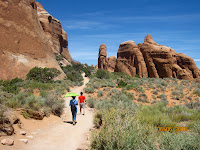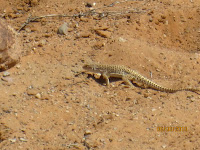2. Once off 191 we came to the Visitor Centre fairly quickly.

 Located on the foothill, it is beautifully designed making full use of local material. A tall glass lined one side of the building, revealing from inside a striking red rock mountain slope behind. It was crowded with many students and their teachers, probably on a study trip. After gathering the necessary material, it was a drive up a steep winding slope, with great anticipation on what to expect up and behind the red sandstone hills.
Located on the foothill, it is beautifully designed making full use of local material. A tall glass lined one side of the building, revealing from inside a striking red rock mountain slope behind. It was crowded with many students and their teachers, probably on a study trip. After gathering the necessary material, it was a drive up a steep winding slope, with great anticipation on what to expect up and behind the red sandstone hills.3. Arches National Park is located in Eastern Utah, 200 sq miles in size, and is known to have some 2000 natural sandstone arches, including the famous Delicate and Landscape Arches. Its
 height ranges between 4000 and 6000 ft. The national park lies atop salt bed, which is the main cause of the formation of the arches, spires, balanced rocks, fins, and eroded monoliths in the area. This salt bed is thousands of feet thick in places, and was deposited some 300 million years ago when a sea flowed into the region and eventually evaporated. Over millions of years, the salt bed was covered with layers of debris and sedimentation and eventually younger sediments mostly eroded away. The arches of the area were developed mostly within the Entrada Sandstone formation, after uplift by volcanic activities and after the softer layers were eroded away.
height ranges between 4000 and 6000 ft. The national park lies atop salt bed, which is the main cause of the formation of the arches, spires, balanced rocks, fins, and eroded monoliths in the area. This salt bed is thousands of feet thick in places, and was deposited some 300 million years ago when a sea flowed into the region and eventually evaporated. Over millions of years, the salt bed was covered with layers of debris and sedimentation and eventually younger sediments mostly eroded away. The arches of the area were developed mostly within the Entrada Sandstone formation, after uplift by volcanic activities and after the softer layers were eroded away.

4. It was wow, after turning the corner with the tall red walls staring at us. It was just sheer magical, much like a
 scene in Indiana Jones movie. The first stop was aptly named Park Avenue, with tall walls in a boulevard. Between the tall walls is a 1 mile moderately difficult trail to Courthouse Towers which on hindsight we should have tried.
scene in Indiana Jones movie. The first stop was aptly named Park Avenue, with tall walls in a boulevard. Between the tall walls is a 1 mile moderately difficult trail to Courthouse Towers which on hindsight we should have tried.5. As we negotiated the bend to the left we were immediately confronted with a number of stunning formations. They came with names like (from right to left) Tower of Babel, The Organ, Three Gossips (can see the 3 people talking?) and etc.




6. Other than arches, Balanced Rock is the other major attraction of Arches. The rock sitting delicately on top had fascinated many generations of visitors but nobody could be certain on how long more it would remain there. The same applies to some of the arches too.

7. Along the route from Balanced Rock we came to the first series of arches, namely Double Arch, North and South Window, and Double Turret (clockwise).



 8. Around these arches we trekked along a "primitive" trail which gave us a good 360 degree view of the formations. It was fairly easy to do, though the term "primitive" gave us some initial concern.
8. Around these arches we trekked along a "primitive" trail which gave us a good 360 degree view of the formations. It was fairly easy to do, though the term "primitive" gave us some initial concern.

9. Next stop we made was Fiery Furnace. The formation got its name not from the heat but from the unusual red look during sunset. I reckon it should look more red if we had waited for another hour or so for the sun to set more.


10. Our last stop for the day was Delicate Arch. We took the moderately strenuous 0.5 mil hiking trail to see Delicate Arch,
 which took half an hour for the loop. From there, we had a fairly good view of the arch, but was not able to get near. The alternative trail to the arch would take 2-3 hrs, a 3 miles round trip.
which took half an hour for the loop. From there, we had a fairly good view of the arch, but was not able to get near. The alternative trail to the arch would take 2-3 hrs, a 3 miles round trip.
11. On way out, I saw this interesting rock formation that looked like a clay pot.
12. We returned to the Arches National Park the next morning to

 see the Landscape Arch which we decided the previous day to leave it to the next day. It's 1.6 miles loop and took about an hour. The
see the Landscape Arch which we decided the previous day to leave it to the next day. It's 1.6 miles loop and took about an hour. The 
 Trailhead is at Devil Garden and it was already crowded when we reached there.
Trailhead is at Devil Garden and it was already crowded when we reached there.13. Hike there was up and
 down but not too hard, but it was hot. On the way, we saw this desert lizard.
down but not too hard, but it was hot. On the way, we saw this desert lizard.14. Like the Delicate Arch, the Landscape Arch also looked like it could break any time. Apparently a few years pieces of
 fragment fell when there were a number of
fragment fell when there were a number of  visitors standing bel0w it. Now, visitors were not allowed to go below the arch. Nearby to the right of Landscape Arch was Tunnel Arch.
visitors standing bel0w it. Now, visitors were not allowed to go below the arch. Nearby to the right of Landscape Arch was Tunnel Arch.

15. During the trips to the various parks I had been amazed by the beauty of these Juniper trees. They looked old, twisted and crumbled but they were alive. In their own way, they were beautiful.
16. Not forgetting the pretty flowers, which coloured the landscape.





17. A few words about the toilets in the National Parks. Here, you see pictures of one in Arches. In spite their heavy usage, they were odourless and clean, and no flushing required. I am not sure how they worked but certainly they would come handy for other national parks elsewhere.
18. After Arches, we were off to Escalante to stay a night before going to see Bryce National Park.

Native Americans have lived in the Bryce Canyon area for about 10,000 years, since local native American tribes include the Anasazi and Paiute Indians.
ReplyDeletePlaces to Stay in Bryce National Park